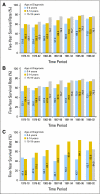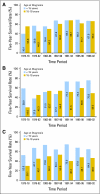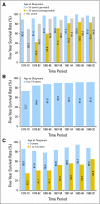Outcomes for children and adolescents with cancer: challenges for the twenty-first century
- PMID: 20404250
- PMCID: PMC2881732
- DOI: 10.1200/JCO.2009.27.0421
Outcomes for children and adolescents with cancer: challenges for the twenty-first century
Abstract
Purpose: This report provides an overview of current childhood cancer statistics to facilitate analysis of the impact of past research discoveries on outcome and provide essential information for prioritizing future research directions.
Methods: Incidence and survival data for childhood cancers came from the Surveillance, Epidemiology, and End Results 9 (SEER 9) registries, and mortality data were based on deaths in the United States that were reported by states to the Centers for Disease Control and Prevention by underlying cause.
Results: Childhood cancer incidence rates increased significantly from 1975 through 2006, with increasing rates for acute lymphoblastic leukemia being most notable. Childhood cancer mortality rates declined by more than 50% between 1975 and 2006. For leukemias and lymphomas, significantly decreasing mortality rates were observed throughout the 32-year period, though the rate of decline slowed somewhat after 1998. For remaining childhood cancers, significantly decreasing mortality rates were observed from 1975 to 1996, with stable rates from 1996 through 2006. Increased survival rates were observed for all categories of childhood cancers studied, with the extent and temporal pace of the increases varying by diagnosis.
Conclusion: When 1975 age-specific death rates for children are used as a baseline, approximately 38,000 childhood malignant cancer deaths were averted in the United States from 1975 through 2006 as a result of more effective treatments identified and applied during this period. Continued success in reducing childhood cancer mortality will require new treatment paradigms building on an increased understanding of the molecular processes that promote growth and survival of specific childhood cancers.
Conflict of interest statement
Authors' disclosures of potential conflicts of interest and author contributions are found at the end of this article.
Figures








References
-
- National Cancer Institute, Surveillance, Epidemiology, and End Results (SEER) Population Estimates Used in NCI's SEER*Stat Software. http://seer.cancer.gov/popdata/methods.html.
-
- National Cancer Institute, Surveillance, Epidemiology, and End Results (SEER) Program. SEER*Stat Database: Incidence—SEER 9 Regs Limited-Use, November 2007 Sub (1973-2006)
-
- Steliarova-Foucher E, Stiller C, Lacour B, et al. International Classification of Childhood Cancer, third edition. Cancer. 2005;103:1457–1467. - PubMed
-
- Kim HJ, Fay MP, Feuer EJ, et al. Permutation tests for joinpoint regression with applications to cancer rates. Stat Med. 2000;19:335–351. - PubMed
-
- Nachman J. Clinical characteristics, biologic features and outcome for young adult patients with acute lymphoblastic leukaemia. Br J Haematol. 2005;130:166–173. - PubMed
Publication types
MeSH terms
Grants and funding
LinkOut - more resources
Full Text Sources
Medical
Miscellaneous

